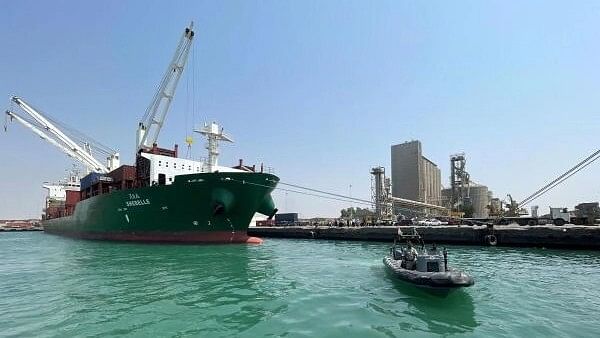
A coastguard boat sails past a commercial container ship docked at the Houthi-held Red Sea port of Hodeidah, carrying general commercial goods.
Credit: Reuters Photo
Seoul: More manufacturers are seeking to fly their products in the next few weeks as attacks on Red Sea shipping force them to find alternate routes, logistics firms say, a potential boon for a sector dealing with muted post-pandemic demand and overcapacity.
The Red Sea, which leads to the Suez canal, lies on the key east-west trade route from Asia's manufacturing hubs to Europe and onto the east coast of the Americas. About 12 per cent of world shipping traffic accesses the Suez Canal via its waters.
But more than two months of attacks by Yemen's Houthi militia on ships in the region have affected companies and alarmed major powers in an escalation of Israel's war with Palestinian Hamas militants in Gaza.
While air freight prices have so far remained relatively stable as the shipping crisis coincides with a seasonal lull in demand, data from freight booker Freightos showed rates on a China-to-Europe route had surged 91 per cent week-on-week on Sunday.
Price reporting agency TAC Index also said there were signs of an uptick in China-to-Europe air freight rates this week.
"We are talking to many customers already about increased air capacity," said Yngve Ruud, head of Air Logistics at global logistics firm Kühne+Nagel. "We have probably 20-30 per cent more discussions and proposals than usual in January."
Air freight is costly compared to sea freight, and not competitive for bulky, low-margin items. Such constraints have limited air cargo to less than 1 per cent of global trade by volume, according to airline industry association IATA.
But since the attacks, which have forced shippers to take costlier routes that can add weeks to delivery times, air freight has become a more attractive option.
Korean Air Cargo, one of the world's largest carriers by volume, said it was starting to see an increase in demand and more customer inquiries.
Several logistics firms including Germany's Schenker, France's Bollore Logistics and US-based C H Robinson are also securing additional air freight space, the companies said, and Chrysler parent Stellantis said last week it was relying on air freight to cope with temporary disruptions.
"As the price of ocean goes up, as the transit times increase, and as backlogs build up, that's when shippers start to get very concerned that they won't have their spring inventory," said Neel Jones Shah, chief customer officer at digital freight forwarder Flexport.
"The first thing you're going to see convert is shippers that do 20 per cent air 80 per cent ocean for the same product, go to 50:50."
MULTI-MODAL OPTIONS
A slowdown in the global economy has helped to mute the impact on trade flows from the attacks by the Iran-aligned Houthis, who say they are acting in solidarity with the Palestinians in Gaza.
The Baltic Air Freight Index, which shows general cargo weekly transactional rates, has fallen since early December and was down 34 per cent last week from a year ago. Global cargo demand was down 2.5 per cent in November from the same month before the pandemic, while capacity increased 4.1 per cent, according to IATA.
Logistics sources say customers are increasingly looking into multi-modal routes, shipping by sea into the Middle East, for example, and then onwards to Europe by air.
Kühne+Nagel said some customers have started sending containers to Dubai and Los Angeles and then flying the goods onwards to their destinations.
Asia-focused freight forwarder Dimerco also said customers were calculating costs for sea-air combinations via Dubai as well as direct air freight services.
Air, however, still remains an option, rather than the default, as customers hold off on committing amid sluggish demand and as many factories in manufacturing hub China prepare to close for the Lunar New Year holiday in February, Dimerco spokesperson Alvin Fuh added.
But the longer the Red Sea crisis continues, the more manufacturers will turn to air freight, shippers said.
"The longer the situation persists, the more pressure is added to sea freight capacity and customers' supply chains, thereby going closer and closer to the 'tipping point' for a need for air freight conversion," said Jack Liu, Senior Vice President of Air Logistics at Kühne+Nagel Asia Pacific.